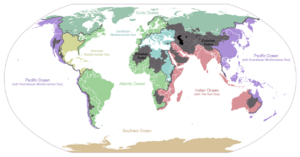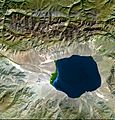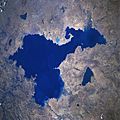Endorheic basin facts for kids
An endorheic basin, also called an internal drainage system, is a special kind of watershed where water collects but doesn't flow out to the ocean. Think of it like a giant bathtub with no drain leading to the sea! Instead, the water in these basins usually ends up in a salty lake or a dry salt flat. You can find endorheic basins all over the world, but they are most common in desert areas where there isn't enough rain for rivers to reach the ocean.
Contents
Major Endorheic Basins Around the World
Antarctica
Even in icy Antarctica, there are endorheic lakes! They are found in the McMurdo Dry Valleys, which is the largest area in Antarctica not covered by ice.
- Don Juan Pond in Wright Valley is a very salty pond that stays unfrozen all year, fed by underground water.
- Lake Vanda in Wright Valley has a permanent ice cover. It's fed by the Onyx River, Antarctica's longest river, and is very deep and super salty.
- Lake Bonney in Taylor Valley also has an ice cover. It gets water from melting glaciers and a unique red flow called Blood Falls. Its bottom waters are very salty, while the top is fresh.
- Lake Hoare, also in Taylor Valley, is the freshest of these lakes, getting its water mostly from the Canada Glacier.
- Lake Fryxell, near the Ross Sea in Taylor Valley, has an ice cover and gets water from many melting glaciers. It gets saltier the deeper you go.
Asia
A huge part of western and Central Asia is one giant inland basin. It includes some very famous lakes:
- The Caspian Sea is the largest lake on Earth! A big part of Eastern Europe, including the Volga River, drains into it.
- The Aral Sea has shrunk dramatically because its rivers were used for farming. This caused a big environmental problem.
- Lake Balkhash in Kazakhstan is another large lake in this region.
- The Dead Sea, located between Israel and Jordan, is the lowest point on Earth's surface and one of the saltiest bodies of water. You can float easily in it!
- Lake Van in Turkey is one of the world's largest endorheic lakes.
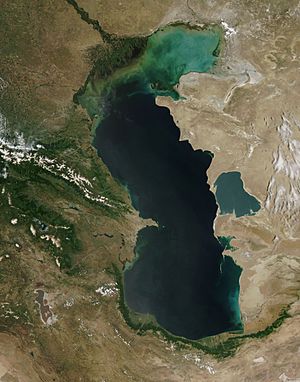
Australia
Australia is a very dry continent, so it has many endorheic basins.
- The Lake Eyre Basin drains into Lake Eyre, which is often dry but can become Australia's largest lake after heavy rains.
- Lake Torrens is west of the Flinders Ranges in South Australia.
- Lake Corangamite in western Victoria is a very salty lake formed in a volcanic crater.
- Lake George in New South Wales used to be connected to a major river system but is now an endorheic lake.
Africa
Africa also has several important endorheic basins:
- Lake Turkana in Kenya is a large desert lake.
- The Okavango Delta in Botswana is a unique inland delta. The Okavango River flows into the Kalahari Desert and spreads out, creating a huge wetland that doesn't reach the sea.
- Lake Chad, located between Chad and Cameroon, is fed by the Chari and Logon rivers. Its size changes a lot depending on rainfall.
- The Etosha pan in Namibia is a large, dry salt pan that sometimes fills with water.
- The Qattara Depression in Egypt is a very large, deep basin below sea level.
North and Central America
North and Central America have many endorheic basins, especially in dry areas.
- Bolsón de Mapimí in northern Mexico is a large desert basin.
- The Great Basin, which covers much of Nevada and Utah, is a huge endorheic region. It includes:
- The Black Rock Desert in Nevada, famous for land speed records and the Burning Man festival.
- Death Valley in California and Nevada, the lowest land point in the United States.
- Utah’s Great Salt Lake, the largest salty lake in the Western Hemisphere.
- The Salton Sea in California, which was accidentally created in 1905 when irrigation canals broke.
- Mono Lake in California, known for its unique tufa towers.
- Crater Lake in Oregon is a beautiful deep lake formed in a volcanic crater.
- Devil's Lake (Wisconsin) is an endorheic lake in Wisconsin.
- Tulare Lake in California was once a large lake, but most of its water has been used for farming. It still floods occasionally after very heavy rains.
- The Valley of Mexico, where Mexico City is located, used to have five large lakes, including Lake Texcoco, which were mostly drained over time.

Europe
Europe has fewer large endorheic basins compared to other continents, but some notable ones exist:
- Neusiedlersee/Fertő tó is a shallow lake on the border of Austria and Hungary.
- Lake Trasimeno in Italy is the fourth largest lake in Italy.
- Lake Prespa is shared by Albania, Greece, and Macedonia.
- Many of these European lakes are now connected to rivers or other water systems by human-made canals or through underground karstic formations.
South America
- The Altiplano basin in the Andes mountains is one of the largest and highest endorheic basins in the world. It includes famous salt flats like the Salar de Uyuni.
- Lake Valencia in Venezuela is the second largest lake in the country.
- The Salar de Atacama in the Atacama Desert of Chile is a very dry and salty basin.
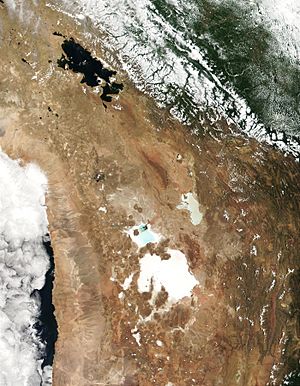
Ancient Endorheic Systems
Some places that are not endorheic today used to be in the past:
- The Black Sea was once an endorheic lake before it connected to the Mediterranean Sea.
- The Mediterranean Sea itself was an endorheic basin about 5 million years ago during a time called the Messinian desiccation. It became disconnected from the Atlantic Ocean and almost dried up!
- Lake Bonneville in the western US was a huge ancient lake that covered much of present-day Utah. The Great Salt Lake is a remnant of this much larger lake.
Images for kids
-
Endorheic basin showing waterflow input into Üüreg Lake, Mongolia
-
NASA photo of the endorheic Tarim Basin, China
-
The Okavango Delta (centre) of southern Africa, where the Okavango River spills out into the empty trough of the Kalahari Desert. The area was a lake fed by the river during the Ice Ages (national borders are superimposed)
-
The Lasithi Plateau in Crete
-
The dry lake in the Badwater Basin in Death Valley National Park
See also
 In Spanish: Cuenca endorreica para niños
In Spanish: Cuenca endorreica para niños


